
Your screenplay is in its final draft. You’ve tightened the plot, checked the formatting, edited for spelling and grammar.
You are confident that it is brilliant. Now you want to send it out into the world.
Before you start hunting down agents, producers, showrunners, and actors to read your script, you need to have an armory of script-selling tools.
Those agents, producers, showrunners, and actors need convincing. They will probably ask for one or more of these selling tools before they read your script.
It’s up to you to prepare those tools and have them ready whenever someone asks for an introduction to your script.
What Documents Do I Need to Sell a Screenplay?
It’s not enough to have a compelling screenplay. As you go about selling your screenplay, you’ll need to take a few extra steps to ensure your script has the best chance of being optioned.
Here are the five essential documents you need to sell a screenplay:
- Logline
- Elevator Pitch
- One-Sheet or Pitch on Paper (POP)
- Synopsis / Treatment
- Query
We’ll look at each one so you’ll know what it is and also its role in selling your script.
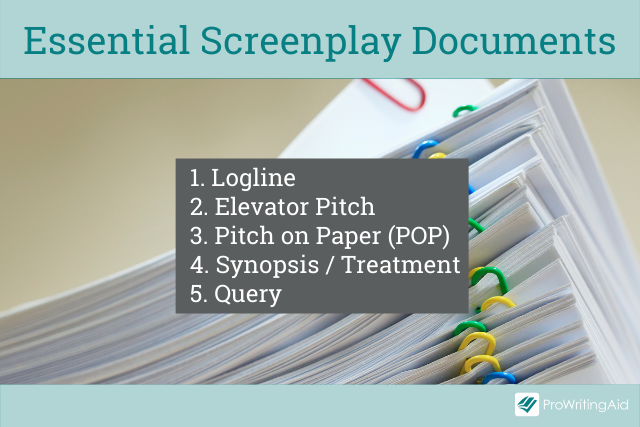
What Is a Logline?
The logline is your story distilled to about thirty words. You highlight a hook and the basic elements.
Paint the basic elements in broad strokes. Think of your logline as a one-sentence summary designed to create interest in your script.
The essence of the logline is the high concept, the tone, and the core emotion. Less is more in a logline.
Keep it between 25 and 50 words. Show the concept of the story rather than telling the story.
- The story world and genre
- The protagonist and their moral dilemma
- The protagonist’s goal and the opponent
- The protagonist’s choice or action
Screencraft provides a basic formula to work on your logline:
When [Inciting Incident Occurs]...
A [Character Type]...
Must [Objective]...
Before [Stakes].
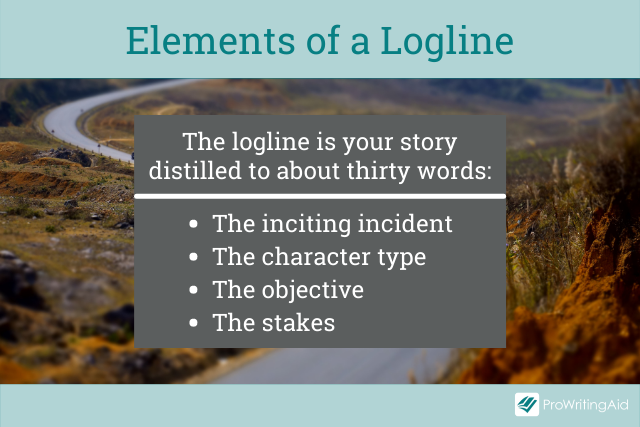
But, writing a logline is not a fill-in-the-blanks process. You can use the formula to make sure the basic elements are in your logline, but your concept still needs to sound exciting.
Here are some logline examples:
- Two imprisoned men bond over a number of years, finding solace and eventual redemption through acts of common decency. (The Shawshank Redemption)
- An organized crime dynasty’s aging patriarch transfers control of his clandestine empire to his reluctant son. (The Godfather)
- When the menace known as the Joker wreaks havoc and chaos on the people of Gotham, Batman must accept one of the greatest psychological and physical tests of his ability to fight injustice. (The Dark Knight)
- A jury holdout attempts to prevent a miscarriage of justice by forcing his colleagues to reconsider the evidence. (12 Angry Men)
- The lives of two mob hitmen, a boxer, a gangster and his wife, and a pair of diner bandits intertwine in four tales of violence and redemption. (Pulp Fiction)
PRO TIP: Read loglines in your genre on IMDb for examples.
The logline sounds simple, but it is one of the most difficult writing challenges for screenwriters. Write multiple versions. Then combine and recombine elements until it is pitch perfect.
Watch story development consultant Jeff Lyons’ logline webinar:
How the Logline Helps Sell Your Script
Your aim is to answer a key question in order to sell your script: Is this a script I want to read?
Film professionals are busy. The logline tells them whether your story is one that could interest them. The logline is your script’s calling card. A good logline can result in a request to read the script.
What Is an Elevator Pitch?
An elevator pitch is short, but longer than your logline. The idea is you can interest someone in your script in the time it takes to ride in an elevator.
It’s the answer to the question, What’s your script about?
You want to craft your pitch and then memorize it. This means you can answer that question anytime, anywhere, without stumbling.
The pitch has four basic parts.
The hook: The compelling concept that makes them want to hear more. Example: Imagine a world where everything that seems real is a delusion produced by machines and one man wants to stop those machines.
The extended logline: Flesh out your logline with a brief outline of the three acts. Example from Screencraft: My script is called Jaws and tells the story of a killer shark that unleashes chaos on an island resort — and it’s up to a local police chief, a marine biologist, and an old seafarer to hunt the beast down before it kills again.
A great finish: Yes, you want them to know how it ends. Don’t leave them hanging. Example from Screencraft: It all builds to the final moment of the police chief—remember that he’s afraid of water—alone on the end of a sinking boat in the middle of the ocean with a rifle pointed at this gigantic and menacing great white shark that is swimming towards him with a barrel of compressed air stuck in its jaws. Smile, you son of a bitch. Boom!
Visual context: Give your script some context by referencing comparable successful films. Convincing them of potential success is both critical and monetary, so pick big winners. It’s all about the money. Examples: It’s Groundhog Day meets Scream. Or, it’s Bonnie and Clyde meets Bladerunner.

Now you’ve told them the story and given references that are easy to visualize.
The elevator pitch helps you speak professionally about your script in any situation.
You want the entire pitch in your head, because people may ask questions or interrupt. It’s important to stay on-topic and give them the entire pitch.
They may not ask for your script yet, but they could ask for a one-pager or a synopsis.
What Is a One-Pager / Pitch on Paper?
The Pitch on Paper or One-Page Synopsis is one sheet that summarizes the basics of your script.
This is your screenplay calling card. You’ll be asked for this often, so it’s important to get it down.
There’s no official format, but the basic information is the same.
Screenplay Title
Writer: Your Name
Phone: +1 (123) 456-7890
Email: youname@emailaddress.com
Genre and/or Logline: A one-sentence summary of your story.
Why It Matters: Very brief explanation of why your story vision matters.
Synopsis:
Act I: Where are we? Who’s it about? What are the problems? Where are we going?
Act II: Success? Failures? What makes it more complicated? How bad can it get?
Act III: How does it fall apart? How does it come back together? How does it end?
Why It Will Succeed: A closing statement from you about why it will be a success in the film market.
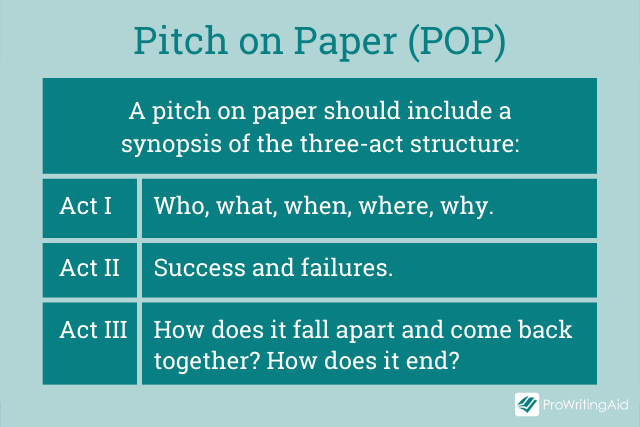
You want information here that will intrigue and invite someone to read your screenplay. Keep it succinct, hit the high points, show how it is funny / scary / action-packed / thrilling / mysterious.
And stress how it fits in the market. Remember, it’s all about money. You are asking them to invest in your screenplay—first with their precious time, and ultimately with money.
How Does a One-Pager Help Sell Your Script?
As an introduction to the concept, your one-pager is designed to encourage a producer or other film professional to request and read your script by giving them all of the necessary information in once place. And, at events like a pitch fest, it helps them remember you.
What Is a Synopsis / Treatment in Screenwriting?
A synopsis or treatment is a longer description of your screenplay. These words are often used interchangeably.
If someone asks you for one or the other, that’s a good sign. In return, ask them what they prefer:
- A quick read
- A detailed treatment
- A highly detailed treatment
What Is a Quick Read Treatment?
A quick read synopsis or treatment is about three pages long but can go up to ten pages, taking the reader through the basic elements of the story—all three acts, including the end.
This is an expansion of the one-pager with more plot and character details. Cover the major story points without going into subplots or details.
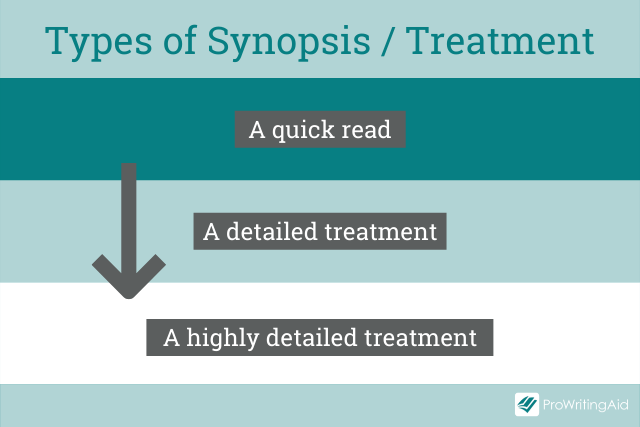
What Is a Detailed Treatment?
The detailed treatment ranges from 10 to 20 pages. This covers every scene, still with the most emphasis on the main story line.
What Is a Highly Detailed Treatment?
A highly detailed treatment covers every scene. Depending on the purpose, it may or may not include certain lines of dialogue.
How Do I Write a Synopsis / Treatment for My Screenplay?
Writers create a treatment for different reasons. There’s no set formula for treatments, but you’ll want to showcase your creative vision and your voice in telling a story.
The length and complexity of the synopsis depends on the purpose.
There are two primary goals in writing a treatment:
- To work through the entire story, including subplots, before writing the script
- To generate production interest
What Should I Include in a Screenplay Treatment?
When you write for yourself, there are no rules. But, if you are looking for interest, you need to include some basic elements:
- Title
- Your name
- Logline
- Concept
- Theme
- Summary of all three acts, with succinct but rich descriptions of the plot points, locations and characters
- Concise exposition and context, if needed

Write in the present tense, as you would your screenplay. Include relevant turns and reversals. Maintain a voice that fits the story genre, but don’t overdo it by slipping into cliché.
Unless you are writing a highly detailed treatment, minimize or cut subplots. The idea is to show your movie to the reader.
PRO TIP: Film is a visual medium. Consider adding a few images to highlight plot elements or suggest main characters.
How Treatments Help Sell Your Script
When you write a treatment for yourself, you’ll understand the entire story before you write the script.
When the treatment goes out to people in the industry, they will understand the who the major characters are and what drives them, the flow of the story, and how you work the theme.
The synopsis is the selling piece that makes them want to read the script.
You only get one shot at a first impression, especially in the film industry. Before you send your logline, pitch, one-pager, or treatment to anyone, run it through ProWritingAid. Not only will it catch any embarrassing grammar errors, it can also help you cut distracting repetitive language, emotion tells, overused words, and more.
ProWritingAid integrates with Final Draft, Word, Google Docs, and your browser so you can edit wherever you write.
What Is a Query Email?
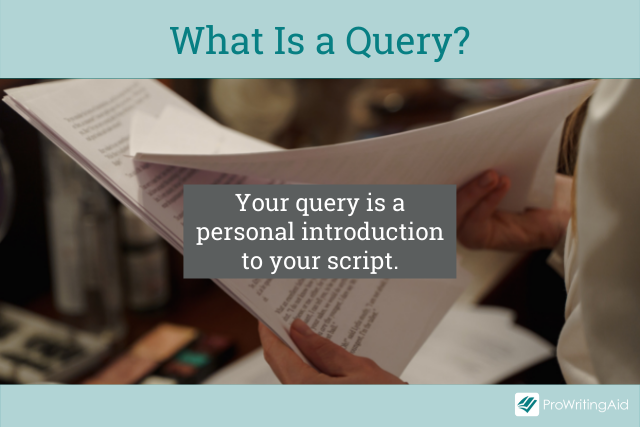
Your query is a personal introduction to your script. These days, you’ll use an email message rather than a letter.
Make your query brief. Industry people, especially managers, are busy.
Sadly, most queries are deleted. But they are more likely to read a short message before deleting. If they see a wall of text, they’ll delete without even giving it a shot.
How Do I Write a Query Email?
Always address the email to a particular person. Include a logline and a simple, short personal bio.
Mention how you met (e.g. at the Austin Film Festival), a referral from a specific person, or how the script placed highly in a well-recognized contest (e.g. Nicholl).
Prepare your query, but use it judiciously. You don’t want to make a name for yourself sending scattershot emails.
Check out Screencraft for some tips and query samples.
But don’t hold your breath. No Film School wrote guidance about the current futility of queries and actions you should take instead.
PRO TIP: Film execs often don’t want to open query emails for legal in case they make a film with a similar logline in the future. Your best bet for getting your movie out there is through networking.
Where Should You Start to Sell Your Screenplay?
Managers get you agents, and agents get you film deals. So, your first step is to find a manager.
If this is your first script, write another screenplay. You’ll need at least two scripts to be picked up by a manager.
When you present your script and are asked, "What else do you have?" you’ll be prepared.
It’s a competitive world. The BBC quoted film consultant Vincent Bruzzese, who said:
100,000 scripts are submitted into the Hollywood system each year and about 300 movies are made. Typically, about 10 of those movies actually produced are from first-time writers.
Network Like Your Script Depends on It
Networking is the best way to meet people in the industry. Screencraft advised:
Networking is how most deals get packaged. Cold query emails, while important, are shots in the dark. Networking is how you tilt the odds in your favor.
While you are writing your next script, start creating connections.
While you are looking for producers, directors, and actors who may be interested in your script, develop connections with other writers.
They are a source of referrals. There may be a project that is not right for them, but just right for you. If they don’t know you, they can’t refer you.
Attend writers’ conferences and film festivals. Meet people.
Give your script some credentials by entering major contests. Contests give you two benchmarks:
- How competitive your script is in the screenwriting world
- Awards give your script credibility
If you aren’t there already, join IMDb. Then research the people who would be interested in your story. Look for industry professionals who have been involved in projects similar to yours.
Don’t waste your time or energy on those who haven’t. Targeting is a better use of your energy than a shotgun approach.
Use a spreadsheet or app like Trello to track connections and schedule follow-up actions.
While your script comes first, your personality can make or break a deal. It’s fine to be assertive about your story, but arrogance can break a connection. Stay proud of your screenplay, but be humble,
Look one more time at your script. Make sure it is marketable, has a reasonable budget, and will sell well at the box office.
Take Your First Steps
This article is your introduction to what lies ahead for you and your brilliant script.
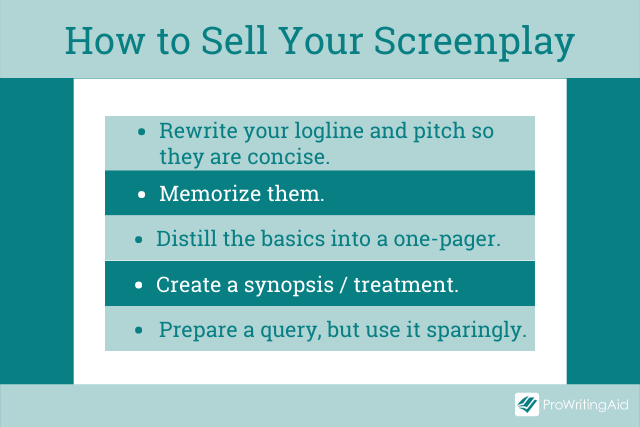
- Write and rewrite your logline and pitch so they are concise and punchy.
- Memorize them so you can speak about your script without stumbling.
- Distill the basics into a one-pager to hand out after a pitch.
- Create a synopsis/treatment you can send out whenever you are asked.
- Prepare a query, but use it sparingly.
Go out and meet people. Networking is your path to script discovery.
Then, when someone asks for your script, make sure it reads perfectly by running the final draft through ProWritingAid.

